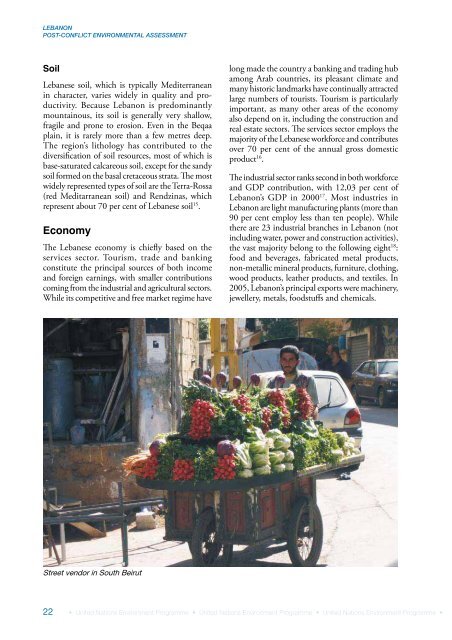Lebanon Post-Conflict Environmental Assessment - UNEP
Lebanon Post-Conflict Environmental Assessment - UNEP
Lebanon Post-Conflict Environmental Assessment - UNEP
Create successful ePaper yourself
Turn your PDF publications into a flip-book with our unique Google optimized e-Paper software.
LEBANONPOST-CONFLICT ENVIRONMENTAL ASSESSMENTSoilLebanese soil, which is typically Mediterraneanin character, varies widely in quality and productivity.Because <strong>Lebanon</strong> is predominantlymountainous, its soil is generally very shallow,fragile and prone to erosion. Even in the Beqaaplain, it is rarely more than a few metres deep.The region’s lithology has contributed to thediversification of soil resources, most of which isbase-saturated calcareous soil, except for the sandysoil formed on the basal cretaceous strata. The mostwidely represented types of soil are the Terra-Rossa(red Meditarranean soil) and Rendzinas, whichrepresent about 70 per cent of Lebanese soil 15 .EconomyThe Lebanese economy is chiefly based on theservices sector. Tourism, trade and bankingconstitute the principal sources of both incomeand foreign earnings, with smaller contributionscoming from the industrial and agricultural sectors.While its competitive and free market regime havelong made the country a banking and trading hubamong Arab countries, its pleasant climate andmany historic landmarks have continually attractedlarge numbers of tourists. Tourism is particularlyimportant, as many other areas of the economyalso depend on it, including the construction andreal estate sectors. The services sector employs themajority of the Lebanese workforce and contributesover 70 per cent of the annual gross domesticproduct 16 .The industrial sector ranks second in both workforceand GDP contribution, with 12,03 per cent of<strong>Lebanon</strong>’s GDP in 2000 17 . Most industries in<strong>Lebanon</strong> are light manufacturing plants (more than90 per cent employ less than ten people). Whilethere are 23 industrial branches in <strong>Lebanon</strong> (notincluding water, power and construction activities),the vast majority belong to the following eight 18 :food and beverages, fabricated metal products,non-metallic mineral products, furniture, clothing,wood products, leather products, and textiles. In2005, <strong>Lebanon</strong>’s principal exports were machinery,jewellery, metals, foodstuffs and chemicals.Street vendor in South Beirut22 • United Nations Environment Programme • United Nations Environment Programme • United Nations Environment Programme •
















